THE SYRIAN CONFLICT: Escalation of a war between the US/NATO and Russia
TMR Editor’s Note:
Jim Autio at DEEP CONNECTIONS has deconstructed the ongoing Syrian War scenario in a critical manner not seen anywhere else on the World Wide Web. The following intelligence briefing lays bare the many complex components of this truly global conflict that is masquerading as a regional war. Jim quite deftly unpacks the difficult complexities in ways unequalled in the private intelligence industry.
The following global geopolitical analysis penetrates many of the most consequential aspects of the ever-evolving quagmire in the Northern Levant. This DEEP CONNECTIONS perspective provides a sweeping overview and unique assessment of some of the most precarious elements of the war in Syria, Iraq and the Kurdish ‘borderlands’ of Turkey. Jim points out the root causes of the volatility and changeability that manifest as daily skirmishes and month-long battles.
This intelligence briefing ought to be considered by any NGO or private corporation looking to get substantially involved within this theater of war. Likewise, those corporate interests and governmental organizations which are heavily invested with personnel and/or physical plant should be acutely aware of the vital information and data contained therein.
The Millennium Report highly recommends the DEEP CONNECTIONS intelligence platform for both for-profit or non-profit entities that are considering the putting down of a large footprint anywhere near the war-torn areas of the Levant. Both the deep analysis and its far-reaching ramifications are too weighty to ignore, especially when there is a considerable financial investment at stake.
In our studied opinion, the TMR Editors feel strongly that the intelligence agencies and secret services of the U.S. Federal Government should be privy to the vital synthesis offered by the briefing below. Failure to consider such an essential geopolitical evaluation of the integral and peripheral factors of the war in Syria could mean the difference between success and failure of any endeavors undertaken in the region.
The original intelligence briefing can be found at the following link:
http://medium.com/deepconnections/prevailing-gray-swans-6-august-12-2016-329f8118a4b6#.yx6z7lqwz
This briefing is very much a living document which is periodically updated with new and important information on Syria. Therefore, TMR highly suggests that the preceding link be consulted on a regular basis to stay abreast of the critical developments now rapidly occurring in the Northern Levant.
The Millennium Report
August 27, 2016
~~~~~~~~~~~~~~~~~~~~~~~~~~~~~~~~~~~~~~~~~~~~~~~~~~~~~~~~~~~~~~~~~~~~
Prevailing Gray Swans: The Clear and Present Danger List for the Week Ending August 19, 2016
6. Escalation of a war between the US/NATO and Russia originating from the Syrian conflict or from the eastern European border countries (Balkans/Poland)
Deep Background and Threat Forensics: Briefing Focus
Introduction
This intelligence bulletin is complicated because of intentional misinformation by all engaged parties to shape societal narratives (i.e. “propaganda”); flip-flopping of alliances between states, proxies and terrorist groups (“the enemy of your enemy is your friend — but today…”); and immensely powerful and new technologies in the form of communication and weapon systems in the battlespace that have never seen combat simultaneously before between potential state-of-the-art adversaries. Emergent conditions can easily transcend diplomatic precedent and defy prudent constraint in the bat of an eye. This will be explored with recency, nuance and depth for the first time.
Simplifying the process is a focus only on the structural elements of the argument, particularly foreign policy, military strategy, and technology, that interrelate in a manner that produce a cogent argument on why this a Prevailing Gray Swan and not just “another Middle East war” which breeds complacency. The primary message to Americans is that the Syrian Conflict should not be viewed in the same class as regional wars like Iraq and Afghanistan because the Syrian Conflict can quickly become a war directly between the US/NATO forces versus Russia/Iran and not just second-world militaries and/or proxies of the US and Russia fighting in limited geographies with conventional weapons in the recent past.
Everyone should be aware of the differences between US and Russian foreign policy vis-à-vis the use of tactical (“non-strategic”) and strategic nuclear weapons in parallel with recent and near-recent (1990 to present) understandings and misunderstandings of acceptable implementation of new weapon systems and where they are being installed, why they are being installed, who they target and under what conditions they are invoked. The world we live in now is starkly different and governments are not up to the task given an emergent spectrum of very likely dangerous and far-reaching contingencies on the immediate to intermediate event horizons.
The Syrian Conflict: It’s Messy
The Syrian Conflict is messy: both the US and Russia, the two biggest arms dealers on earth, have supplied weapons to nation states and non-state actors only to find those same weapons used against them repeatedly in a lethal carousel. This infographic does not even include weapons given or sold to terrorist proxies through back channels or the burgeoning black market sales:
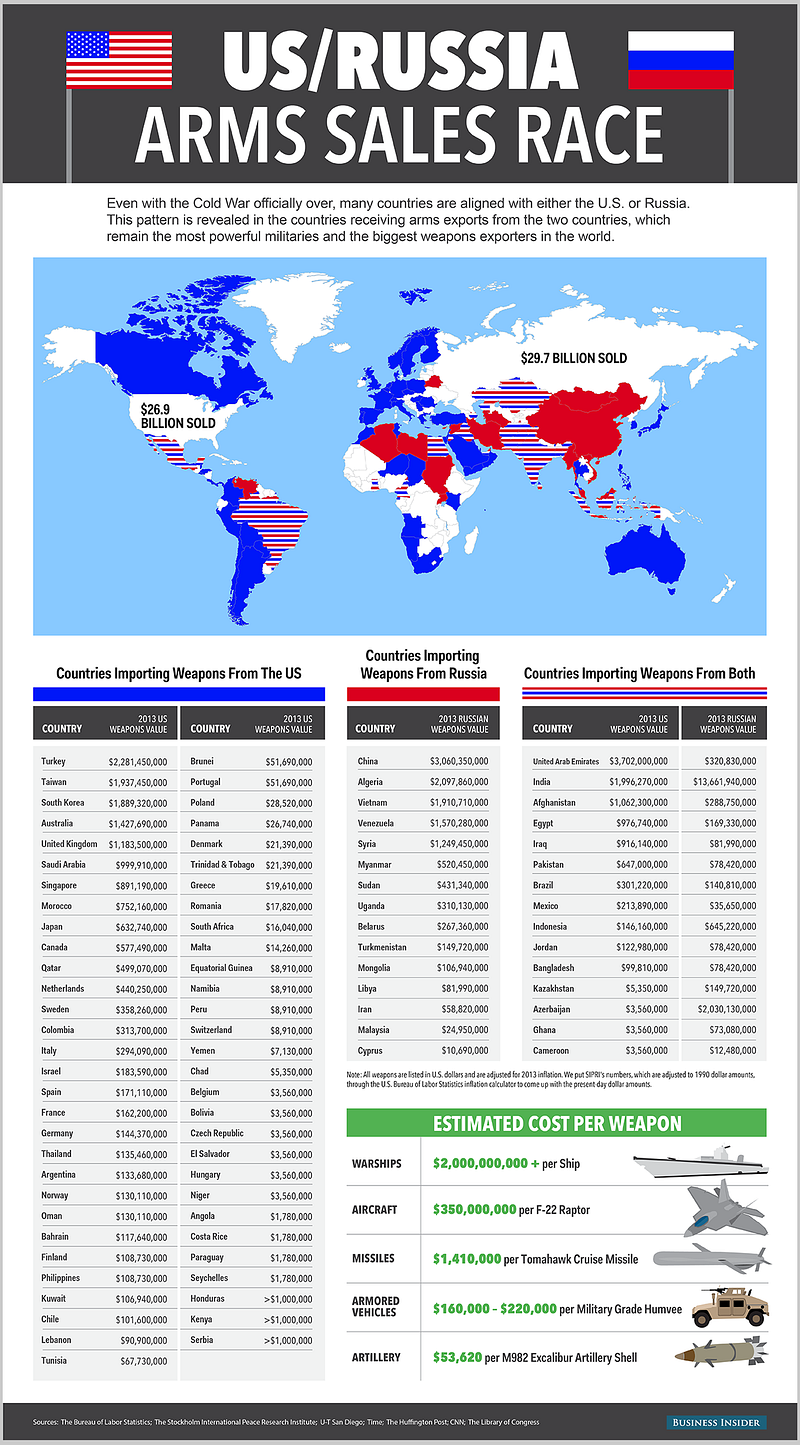
The Syrian Conflict since 2011 has been a magnet for conventional weapons of all kinds used by an uncountable number of small and large groups fighting for many different causes:
[youtube_sc url= http://www.youtube.com/watch?v=1GBAIVVqJPY&w=560&h=315]
Source: Defense One, produced by Ben Watson.
In the case of the Syrian Conflict, not just the supply and types of weapons and who is using the weapons, but why they are using them is equally messy but there is something very different here, even strange. If you filter out the noisy sectarian civil war layer, the remaining battlespace features a wake-up call reminiscent of nightmarish Red-phone contingencies previously only experienced in the Cold War era. When you look at the structural aspects of this conflict, that is, the strategic motivations of the primary belligerents causing such brutal violence and off-the-chart human suffering, and not just the extreme sectarianism which has been endless but at less than civil war intensity, what surfaces as primary drivers are:
- energy concerns;
- goals of the IS (Islamic State aka ISIS, ISIL); and
- goals of adversarial states to Bashar al-Assad, the President of Syria aka“Assad Regime”.
[Background: live map of military situation | detailed description of how Syrian Conflict started | course of events and timeline of Syrian Conflict |What is life like in Syria? ]
- Energy
The Middle East is the breadbasket of global energy and is divided between two long-term historically warring Islamic factions: Shiites and Sunnis. Iran and Syria are under Shiite control whereas Iraq (while under Saddam Hussein), Turkey, Saudi Arabia, Qatar, and the United Arab Emirates are under Sunni control (there are also different sub-sects within them). A major recent geopolitical shift in the Middle East is Iraq going from absolute Sunni control to partial Shiite control with significant back channel influence from Tehran after the US and coalition forces overthrew the previous Sunni government under Saddam Hussein. The reason for this is that the new Iraqi government is under a democratic process and the majority of Iraqis have always been Shiite Arabs (religious breakdown: Shia 60%-65%, Sunni 32%-37% | ethnic breakdown: Arab 75%-80%, Kurdish 15%-20%) but were oppressively suppressed by Saddam Hussein. This was a major victory for Iran, Syria and Russia especially considering that this windfall geopolitical strategic change in the Middle East chessboard was essentially a gift which Iran failed to achieve after a bloody, contracted war between Iran and Iraq in 1980 to 1988. All that was required by Iran this time was the patience for the dust to settle.
What fomented civil war and full-scale insurgency (not just garden-variety sectarian violence) in Syria were contesting plans to build pipelines from the largest natural oil gas field in the world through Syria for eventual sale in European markets. This is the source of the natural gas:
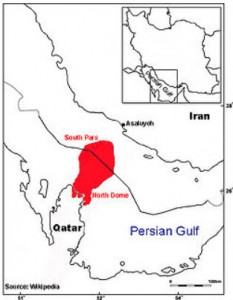
Here are the two competing natural gas pipeline plans; notice that Iraq is now in the Russian-backed Iran-Syria Shiite column:

“Most of the foreign belligerents in the war in Syria are gas-exporting countries with interests in one of the two competing pipeline projects that seek to cross Syrian territory to deliver either Qatari or Iranian gas to Europe,” wroteProfessor Mitchell Orenstein of the Davis Center for Russian and Eurasian Studies at Harvard University.
As Orenstein explained, “in 2009, Qatar proposed to build a pipeline to send its gas northwest via Saudi Arabia, Jordan, and Syria to Turkey… However, Syrian President Bashar al-Assad refused to sign the plan; Russia, which did not want to see its position in European gas markets undermined, put him under intense pressure not to”.
Russia’s Gazprom sells 80 per cent of its gas to Europe. So in 2010, Russia put its weight behind “an alternative Iran-Iraq-Syria pipeline that would pump Iranian gas from the same field out via Syrian ports such as Latakia and under the Mediterranean.” The project would allow Moscow “to control gas imports to Europe from Iran, the Caspian Sea region, and Central Asia.”
(Source: Middle East Eye, October 30, 2015, “The US-Russia gas pipeline war in Syria could destabilise Putin”)
What the Syrian Conflict comes down to is Assad refused to sign the US-backed Qatari plan and instead proceeded with the Russian-backed Iranian-Iraqi plan:
These strategic concerns, motivated by fear of expanding Iranian influence, impacted Syria primarily in relation to pipeline geopolitics. In 2009 — the same year former French foreign minister Dumas alleges the British began planning operations in Syria — Assad refused to sign a proposed agreement with Qatar that would run a pipeline from the latter’s North field, contiguous with Iran’s South Pars field, through Saudi Arabia, Jordan, Syria and on to Turkey, with a view to supply European markets — albeit crucially bypassing Russia. An Agence France-Presse report claimed Assad’s rationale was “to protect the interests of [his] Russian ally, which is Europe’s top supplier of natural gas”.
Instead, the following year, Assad pursued negotiations for an alternative $10 billion pipeline plan with Iran, across Iraq to Syria, that would also potentially allow Iran to supply gas to Europe from its South Pars field shared with Qatar. The Memorandum of Understanding (MoU) for the project was signed in July 2012 — just as Syria’s civil war was spreading to Damascus and Aleppo — and earlier this year Iraq signed a framework agreement for construction of the gas pipelines.
(Source: The Guardian, Nafeez Ahmed, August 30, 2013, “Syria intervention plan fueled by oil interests, not chemical weapon concern”)
Assad refused to sign the US-backed Qatari pipeline deal in 2009 and, instead, signed the Russian-backed Iranian agreement in July of 2012. He had the legal authority to make this decision. Below are the timelines for both death counts and refugee counts (detailed timeline of Syrian Civil War (January 2011-present)):
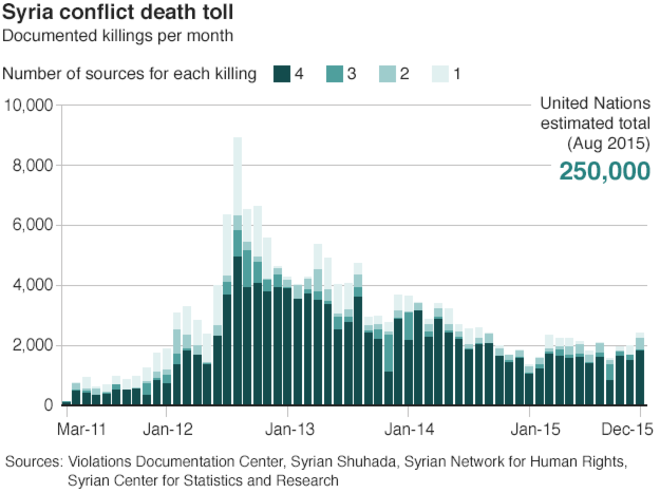
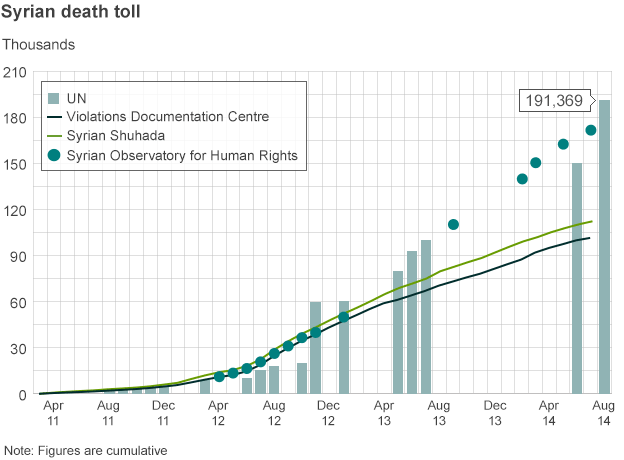
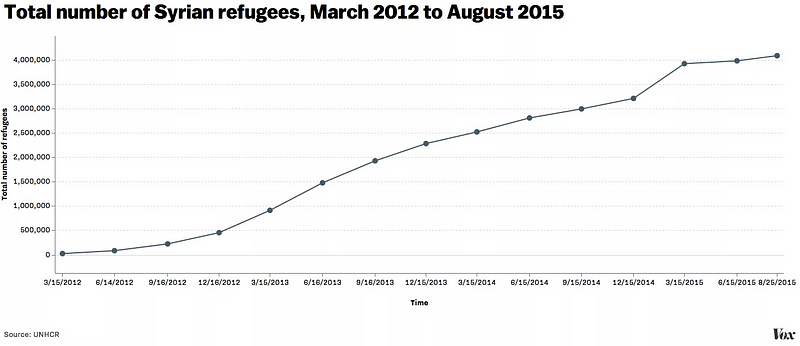
[Statistical database and records on violence in Syria (Source: The Violation Documentation Center in Syria)]
The United Nations estimates that 17.9 million people still live in Syria — down from 24.5 million before the war broke out. More than 6 million of them are classed as internally displaced after being forced to flee their homes to look for somewhere safer to live.
But where do they live? Most provinces have seen a sharp decline in population and many of those that remain have fled the cities to seek shelter in the countryside.
Life goes on as normal in many parts of the capital, Damascus, but elsewhere millions struggle to get by. The UN says 13.5 million people are in need of humanitarian assistance, with 4.5 million of those in hard-to-reach and besieged areas like Deir al-Zour.
(Source: BBC, March 15, 2016, “Life and death in Syria: Five years into war, what is left of the country?”)
The moral of the Syrian refugee tragedy:
“When two elephants fight, it is the grass that suffers.”
— Swahili proverb
*where the “grass” are the Syrian people, refugees and the rank and file of the EU.
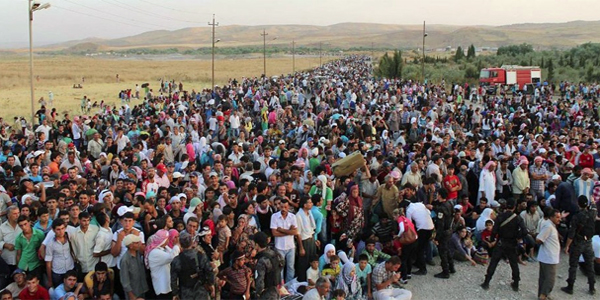
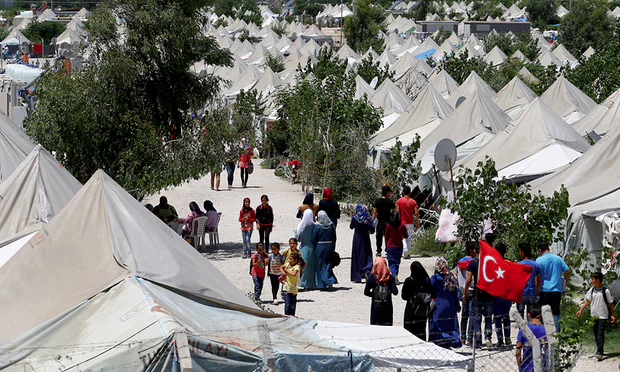
Understand: The civil war, its timing, and the hockey stick increase of death and refugee counts in the same time frame as the natural gas decisions are not coincidental. The impact of which pipeline deal Assad chose to sign from the same natural gas field beneath the Persian Gulf will have enormous impact on the survivability of the EU given the immigration policy of Brussels on the EU member states post-Brexit (and immigration policy certainly was a deciding factor in Brexit given that is was a close vote and a major concern in the UK and underwrites France’s Marine LePen’s (leader of the anti-immigrant Front National party) political platform of “Frexit”):
The scheme was significantly extended in September 2015. The UK is now planning to resettle up to 20,000 refugees from the Syrian region over the next five years. The Government is working with local authorities and the voluntary sector to implement the scheme. It is also developing plans for a ‘community sponsorship’ scheme for Syrian refugees.
The resettled refugees are given five years’ Humanitarian Protection status, with permission to work and access public funds. Official statistics show that 1,602 people had been resettled in the UK under the scheme by the end of March 2016.
(Source: UK Parliament (House of Commons Library), June 10, 2016,“Commons Library briefing: Syrian refugees and the UK response”)
Note date of Brexit vote: June 23, 2016
The current piecemeal response to the crisis, culminating in the agreement between the EU and Turkey to stem refugee flows from the Eastern Mediterranean, suffers from four fundamental flaws. First, it is not truly European; the agreement with Turkey was negotiated and imposed on Europe by German Chancellor Angela Merkel. Second, the overall response is severely underfunded. Third, it has transformed Greece into a de facto holding pen with inadequate facilities. Finally, it is not voluntary: It is trying to impose quotas that many member states strenuously oppose and requires refugees to take up residence in countries where they are not welcome and where they do not want to go while returning to Turkey others who reached Europe by irregular means.
(Source: Foreign Policy, George Soros, July 19, 2016, “This Is Europe’s Last Chance to Fix Its Refugee Policy: The EU’s piecemeal solutions are coming apart. Only a surge of financial and political creativity can avoid a catastrophe.”)

Speaking at a migration conference in Istanbul, Esen Altuğ, Turkey’s deputy director for migration, asylum and visas, said: “There are 3 million [Syrian and Iraqi refugees] already now in Turkey. Until now, 2,000 have been taken by the Canadians. But unfortunately, from European countries, the number is very, very low. So we want something like 500,000 [resettled to Europe]. As a voluntary programme, of course — these Syrians families should want to go to Europe.”
(Source: The Guardian, Patrick Kingsley, May 23, 2016, “Erdoğan calls on Europe to take in more Syrian refugees”)
Pending geopolitical concern: Turkey has significant political leverage over the EU’s fate given the volume of refugees currently within Turkey’s borders and President Erdoğan’s requirement for Europe to share the burden; this is a greatly under-appreciated threat to the fragile global banking system due to future Brexit-like referendums in the pipeline for 2016–17 some of which have more support than Brexit did in the UK.
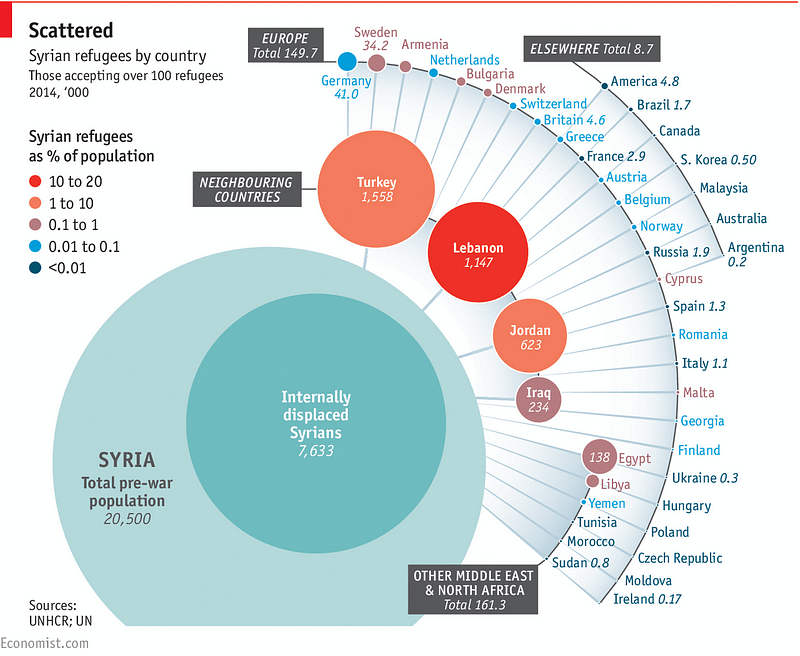
http://twitter.com/syriaintel/status/767717120507535360?ref_src=twsrc%5Etfw
In essence, the Syrian refugee catastrophe acts as a big short on the EU and the survival of the euro. The more the great powers and their proxies destroy the lives of native Syrians, the grimmer the odds that the EU will endure given the sclerotic policies of Brussels and the scale of the refugee tragedy. This is one of the most amazing disconnects in the world today. Even France bombs Syria in retaliation for terrorist strikes which only creates a vicious, positive-feedback loop — call it the terror loop, a means to pay forward violence to innocents elsewhere.
2. The Goal of the Islamic State in the Region
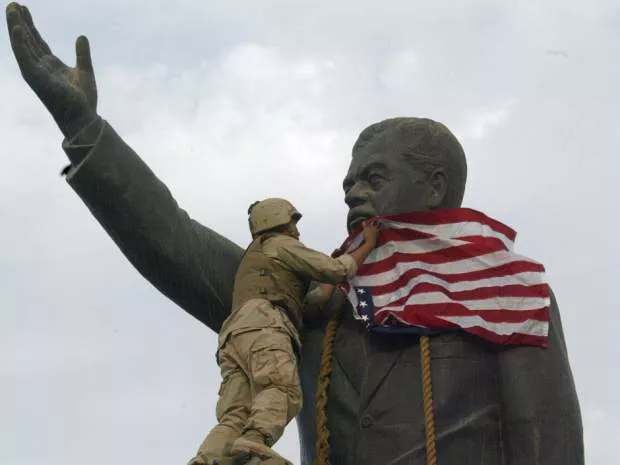
The Islamic State (IS) aka ISIS, ISIL, inherited its organizational nervous system in the aftermath of the US-directed deconstruction of the Iraqi military hierarchy post-Saddam Hussein:
“ISIL, as an organization, would not exist without former Baathists,” says Iraq analyst Sajad Jiyad, a senior researcher at the al-Bayan Center for Studies & Planning in Baghdad. He estimates more than 25 of ISIL’s most prominent 40 leaders in the last two years were previously Baathists [Ed. Saddam Hussein was a Baathist].
Shashank Joshi, a senior research fellow at the Royal United Services Institute, says the Baathists’ significance to ISIL goes beyond numbers. “It’s less important in terms of the contribution to manpower, or sheer heft or size, and more important in terms of the specific skills, connections, linkages and technical expertise that the Baathists bring to the table,” he says.
He cites a range of skills former Baathists have used to propel ISIL’s rise, including knowledge of smuggling networks, familiarity with advanced military technology and significant experience in terrorizing civilians.
(Source: National Post, Davide Mastracci, May 23, 2015, “How the ‘catastrophic’ American decision to disband Saddam’s military helped fuel the rise of ISIL”)
The IS’ objective in Syria (as well as Iraq and elsewhere) is to establish its own geopolitical entity (i.e. the IS caliphate) which features total disregard of existing sovereign borders and UN jurisdiction:
But what is the meaning of declaring an Islamic caliphate? A Salafi cleric says, “It means that borders and barriers among Islamic countries are now invalid. There will be a single Islamic economic system and currency, and an army to defend it.” He continued, “It also means there will no longer be any subservience to any country, requiring the establishment of universities and factories to make Muslims a major power in all fields.”
(Source: Al-Akhbar, June 30, 2014, “What does ISIS’ declaration of a caliphate mean?”)
The proposed IS caliphate encompasses most of existing Syria and large swaths of Iraqi territory:
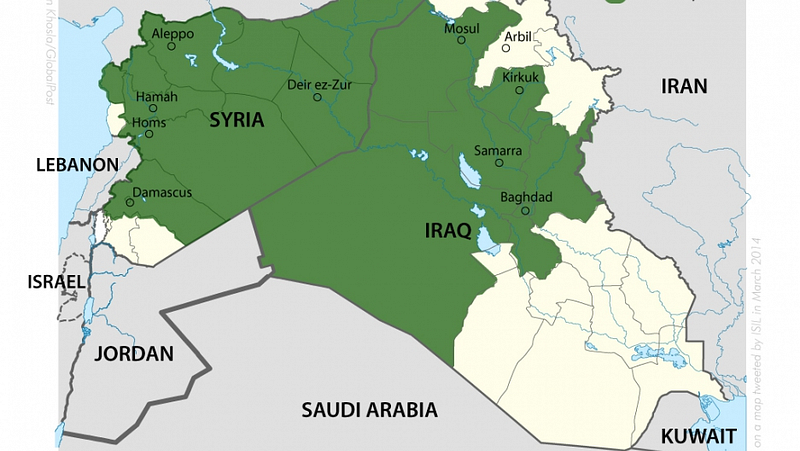
This is obviously something the US, Russia, Syria, Iran, Iraq, Qatar, Kuwait, Saudi Arabia, and the UAE do not want thus the IS is a common enemy of all of the above. But what makes it messy is that the US’ primary objective is to topple the Assad regime and, paradoxically, this theoretically makes the IS US and Saudi Arabian et al allies in Syria (the IS caliphate views the Assad regime and Iraqi government as mortal enemies to their cause) butnot in Iraq or elsewhere — it depends on where — not just who — is friend or foe. Because of these twisted complexities, funding and arming of IS factions can happen through back channels with unofficial “agreements” — there is nothing black and white about the Syrian Conflict*.
*Note: Reports of some of these countries supporting the IS is complex and not addressed here (more…).
3. Goal of the Adversarial States to the Assad Regime and UN Involvement
Proponents of the US-backed Qatari natural gas pipeline want to see regime change with a new compliant Syrian government replacing Assad while Iran, China and Russia wish to defend the status quo. Because of this fundamental conflict, Russia has bombed US-backed and trained rebel forces that threaten the Assad regime while the US actively undermines the Assad regime at every opportunity.
Relationship of Syria, Russia, and Iran
In Syria, Iran and its Hezbollah allies have provided forces on the ground in support of the government in Damascus, along with significant financial support, while Russia provides Damascus with air support, artillery, and intelligence, as well as arms, matériel, and diplomatic cover. Since the start of the Russian military intervention in Syria in September 2015, Moscow has been coordinating its operations there with both Damascus and Tehran, and also has worked closely with the Tehran-friendly government of Iraq.
While Moscow, like Tehran, seeks to prevent the toppling of Syrian President Bashar al-Assad’s regime and the triumph of the Islamist extremists, there is a fundamental divergence between the two governments’ goals. The Russians want to preserve some kind of a Syrian state, under a regime reformed with their active participation — such a regime would continue to be friends with Moscow. Their end goal, however, is not to preserve Assad, over whom they have limited influence, or to maintain Alawite rule. While Russia’s ongoing direct intervention in Syria has prevented the defeat of Assad’s forces, it also has resulted in the relative reduction of Iran’s influence in Damascus.
(Source: Carnegie Moscow Center, Dmitri Trenin, Director, Moscow Center, August 18, 2016, “Russia and Iran: Historic Mistrust and Contemporary Partnership”)
UN Influence
UN resolutions in the public foreground are about arriving at a peaceful political solution in war-torn Syria as well as buttressing media messages about terrorism but in the background are about jockeying for advantageous position relative to the fate of the Assad regime. The US/NATO and Russia have legal authority to use military action against recognized terrorist groups but not against the Syrian government. As expected, the US/NATO side claims that Assad needs to be replaced whereas Russia and China oppose. UN resolutions that interfere with Russian and Chinese interests are vetoed in the Security Council.
In the main street media, destruction of the IS terrorist groups is the dominant narrative for why the US and coalition forces and Russia are on the same side and is the UN mandate — they are killing terrorists which has public support worldwide. Although this is true, it is a very convenient and believable cover story for the principle reason they are so active there and because of this, the Syrian Conflict has evolved into a much larger battlespace which now harbors great risks and consequences that haveglobal — not merely regional — impact. Why is this so?
The Anatomy of the Real Syrian Conflict and What It Means to You
Everything about the Syrian Conflict changed when Russia installed the S-400 surface-to-air missile systems in coastal Syria in late 2015. After Turkey shot down a Russian Su-24 bomber that briefly crossed Turkish airspace on November 24, 2015, this was a perfect pretext to move S-400 air defensive systems into Syria to “prevent further aggressive action from Turkey.” Russian President Vladimir Putin made the announcement of the arrival and deployment of the S-400 systems at the Hmeymim Air Base near Latakia, Syria at a press conference in Moscow soon thereafter. This should have been front page news in the US media because the world became a different place on that day: Russia moved a rook to the center of the chess board without fanfare.
What is the S-400 and why does it change everything?
The S-400 is the world’s most sophisticated air defensive system against all classes of air traffic including the world’s most stealth fighter planes (US F-22 and F-35) and most missile systems including stand-off weapons like the US Tomahawk cruise missiles launched from submarines and ships. The videos shows not only the S-400 but also the other components in the Russian air defense network and be sure to watch them or you will not understand the politics and battlespace when it gets contextualized shortly:
[youtube_sc url= http://www.youtube.com/watch?v=D-_mN2lPdLo&w=560&h=315]
[youtube_sc url= http://www.youtube.com/watch?v=lObxEtVr9yE&w=560&h=315]
_ _ _
The S-400 is one of the most significant developments in military technology that have materially changed the way future conventional wars will be fought because of its phenomenal capabilities:

The Syrian Conflict changed overnight from a regional war to a new form of war because modern military engagements cannot be won without control of the airspace and the S-400 in concert with advanced electronic warfare (EW) technology commands the airspace. What this means is that Russia/Syria possess air supremacy creating an on-demand no-fly zone that is prosecutedfrom the ground and US and NATO air forces must operate on a permission basis. If this were a game of chess, Russia controls the center of the board and now feels free to move her queen out with no worries. Ostensibly, this abrupt change of the rules was to muzzle Turkey but is really about marginalizing the US and NATO if required.
Additionally, the rest of the world took notice of the S-400 like it were a rockstar advertisement and is now on the short list of military acquisitions of nations like China, Iran, Egypt and India because it can be a game changer in many current balance-of-power strategic contexts like: China-US re: Taiwan; India-Pakistan; Iran-Israel; and China-Japan-Vietnam re: South China Sea. For example, American military planes would no longer be able to violate Chinese airspace (i.e. as China interprets sovereign airspace) around the Spratly archipelago if China were to place an S-400 there. Russia recently moved S-400 air defense capability into the Crimean peninsula which projects an operational range deep into Ukrainian airspace [map |more…]. At a cost of only USD 500M per unit, it is an extraordinary bargain given that the cost of a single F-22 Raptor stealth fighter is an estimated USD 377 to 412M.
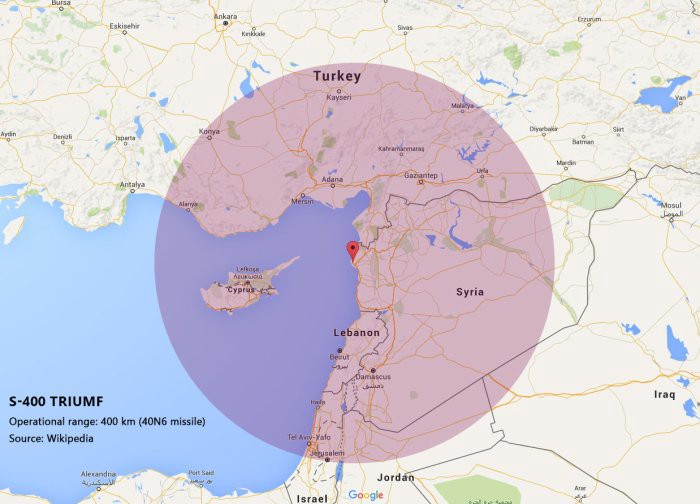
How is the US and NATO dealing with the S-400 Air Defense System?
Russia has used its intervention in Syria to reshape the military and political contest for control of Syria and to deliberately constrict the space for countervailing American action. The idea that America can menace Russia’s regime partner in Syria unilaterally and without consequences is an unreal one. And unless America is willing to risk a dangerous and unpredictable confrontation with Russia, the course of Syria’s war hinges on what Russia does next.
(Source: War on the Rocks, Sam Heller, Twitter: @AbuJamajem, June 28, 2016, “Russia Is in Charge in Syria: How Moscow Took Control of the Battlefield and Negotiating Table”)
U.S. defense officials have raised concerns about the potential threat of the Russian missile system to U.S. pilots, who continue to launch airstrikes against ISIS, also known as ISIL, in Syria and Iraq. Navy Capt. Jeff Davis, the Pentagon spokesman, said earlier this month that Moscow deployed “a capability that we don’t see as being productive in the fight against ISIL.”
“Whether it’s putting air-to-air missiles on planes or putting in surface-to-air missiles, those are things that are clearly not about ISIL, as ISIL doesn’t have any aircraft,” Davis said. “So far it has not had any impact on our operations [over Syria], but it’s certainly something we’re aware of, particularly with the surface-to-air missiles.”
(Source: Washington Free Beacon, December 23, 2015, “Russian Missile System in Syria Threatens U.S. Pilots”)
Russia’s December 2015 deployment of the advanced S-400 air defense system on the Syrian coast is a potentially lethal threat to U.S. pilots attempting to strike the regime. The deployment of the S-400 covers much of Syria, including the entirety of the country’s west, and can also intercept cruise missiles. This deployment contributed to forcing the United States to “de-conflict” its operations in Syria with those of Russia.
Capt. Ryan Hignight, a U.S. military spokesperson for the U.S.-led coalition against the Islamic State, reported to me over e-mail that the coalition does not coordinate specific operations with Russia, but does hold daily phone calls with the Russian military and maintains a memorandum of understanding with the Russian Ministry of Defense to ensure safety of flight by aircrews over Syria.
(Source: War on the Rocks, Sam Heller, Twitter: @AbuJamajem, June 28, 2016, “Russia Is in Charge in Syria: How Moscow Took Control of the Battlefield and Negotiating Table”)
Another facet to this hi-tech theater of battle is the introduction of theLockheed F-22 which saw its first combat mission in 2014 and has now seen action against the IS in Syria:
So far, President Bashar al-Assad hasn’t operated Syria’s air defenses against U.S. airstrikes targeting Islamic State, a mutual enemy, but General Herb “Hawk” Carlisle said the Air Force recognizes the threat they pose.
“There are parts of Syria that are higher or lower threats” and “frankly, we never know for sure what” the Syrians potentially might do “with their fairly highly capable systems”, he said.
“We are very cognizant of Syrian air defenses” and also are still gathering information about the full extent of Islamic State air defenses, he said.
(Source: Bloomberg, February 18, 2015, “The F-22’s Belated Combat Debut Against Islamic State Earns Praise”)
The F-22 was principally designed to be a fifth-generation fighter in modern dogfight and escort capacities and not for heavy lifting like bombing and kinetic ground support. In Syria it is being used more for its sophisticated intelligence gathering and targeting capacity for other planes with larger payloads while coordinated with the electronic warfare variant of the F-18 called the EA-18G Growler [use in Syria]. Russia in the meantime has also deployed at Khmeimim Airforce Base the Krasukha-4 electronic warfare (EW) systems to protect Russian assets from hostile air and space reconnaissance assets (understand that the IS does not have any but the US does). In 2017, it is very likely the much more potent S-500 will be deployed, it is now in test. Also, Russia has its own world-class fighter, the formidable Su-35 which entered combat in Syria in February 2016 [more…]. But this contest is not about the dogfight isolation of F-22 versus Su-35 where the F-22 is clearly superior, it is about US air forces versus Russian air forces and S-400 with other air defenses, missile systems and EW which is not a fair fight.
[Review of Russian EW systems: (Khibiny, Moskva, Krasukha, Rtut’-BM, President-S]
The data obtained from monitoring the F-22 flying combat missions could be used to “[improve] tracking algorithms, air defense capabilities, and [enhance] the understanding of coalition weapons that are engaging in close air support and precision air strikes,” US Air Force Major Jahara ‘Franky’ Matisek asserted.
The US, according to the US pilot, should reconsider using advanced weapons in its campaign to eliminate Daesh. Keeping F-22 characteristics a secret should take priority over other considerations.
It’s not only about the stealth air superiority fighter, the US should refrain from using any advanced avionics. Otherwise, he maintains, Moscow will not miss a chance to observe, collect and adjust its own weapons and strategies accordingly.
(Source: Sputnik News Military & Intelligence, June 12, 2015, “All Seeing Eye: US Risks Exposing Top Secret Data to Russian Recon in Syria”)
Mobile systems of electronic warfare “Krasuha-4” inhibit spy satellites, ground-based radars and airborne AWACS (System Airborne Early Warning and Control — Airborne Warning and Control System, AWACS ). (Source: Strong Russia)
So what is really happening here is that US F-22s and EA-18Gs are spying on Russia’s radar detection and EW networks while Russia is mapping radar signatures by air and ground of the stealth capabilities of the F-22 and EW function of the F-22 and EA-18G. Additionally, both sides have world-class capabilities in cyberwarfare and multiple classes of drones including drones that fool radar. All of this is classic Red Queen evolutionary dynamics which is explored in-depth in the Prevailing Gray Swan on cyberwarfare — spoofing, gathering intel, jamming, and damaging radar andbeing stealth and detecting stealth technology is a never ending game of cat and mouse and is in full force in Syria while no one fires a shot and no one says a word.
What is to understand here is that no one on earth really knows how all of these exotic technologies with fantastic capabilities in theory will fare under no-holds-barred combat conditions and it is always in flux with software updates, hardware tweaks, upgrades and changes in tactics. As Marc Andreessen, a principal inventor of the web browser and cloud computing says: “software is eating the world”; in the world of Syria that means software algorithms one day allow radar to see you and the next day they don’t — and that changes who lives or dies in future conflicts. It is a research laboratory out there that iteratively sharpens each other’s sword. But if you are a US pilot and it fatefully turns hot this is no Top Gun redux. For the first time since WWII, the US military does not hold the Joker cards; the Russians do — and in spades. But this scenario is not what makes the Syrian Conflict a global threat, it only lays the groundwork for a two-headed, not one, gray swan.
Legal and Boots on the Ground Impressions

As important, Russia’s direct entrance into the war very clearly suggests that the end result of any further escalation would be further escalation. And here I do agree with some administration officials who have argued that in the context of Syria, Russia has escalation dominance. Russia’s punishing escalation on Turkish proxies and allies following the November 2015 Turkish shooting down of a Russian fighter jet should produce some caution when thinking through potential escalatory options.
This is particularly the case when it comes to the direct use of U.S. air power against the Assad regime, which would likely lack legal basis in any event. More crucially, though, in light of Russia’s own military engagement and its deployment of substantial air defense systems and personnel in Syria, the prospects for inadvertent U.S.-Russia escalation are quite serious and present an unconscionable risk. And that doesn’t even begin to consider how the United States would approach the suppression of Syrian and Russian air defense systems in regime territory. When critics breezily discuss deploying U.S. air power against Assad, I have a hard time understanding what interests are at stake that could justify such a risk.
(Source: The Century Foundation, Michael Wahid Hanna, July 26, 2016,“Four Perspectives on the War in Syria”)

But this is perhaps where the counter-escalation discussion comes into play. Even if not a single manned aircraft would take part in such strikes, there are a lot of ways in which the opponents of an intervention could respond. Russian S-400s and S-300s could pluck a lot of missiles out of the sky, and U.S. jets flying missions against the Islamic State would also be within their range. Even if Russia does not want to fire at American jets, these advanced missiles could be transferred to Syrian control at the stroke of a pen. Then what? Would the U.S. Air Force respond in kind and start killing the re-flagged Russian missile crews, while pretending that they are Syrians and that that is not a great-power conflict?
In short, Vladimir Putin could make things very complicated for the United States. Even without challenging the U.S. intervention directly, who’s to say he won’t throw a fit and decide to double, triple, or quadruple his air support for Assad? Iran could also easily retaliate against U.S. interests in Iraq and Lebanon.
(Source: The Century Foundation, Aron Lund, July 26, 2016, “Four Perspectives on the War in Syria”)
Foreign Policy: Understanding Russia’s Position, Justifications, and Inclinations
This is at least one thing that 0bama is better at than his nemesis Putin:https://t.co/ijnyd6shNC #tcot #russia #trump #tlot #2a #cartoon
— Ed (@reFocusZone) July 2, 2016
Through mainstream media a new enemy has been manufactured and precision-crafted to art form by gifted spin doctors; Americans have been repeatedly painted a very negative, cartoonish distortion of Putin: “Russia is aggressive” and “Putin is evil, Putin is a bully, Putin is Hitler,” etc. Putin has become the fulcrum for foreign policy optics and this meme has surpassed critical mass to the point of parity with “matter-of-fact” belief by Americans of the absolute presence of weapons of mass destruction in Iraq in the pretext buildup of justification for the Iraq invasion in 2003. But forget about that for a moment, what is crucial to understand is not just how America perceives Russia, but how Russia perceives America and NATO and why.
Pre-1990 USSR and NATO versus Present-day Russia and NATO
There is widespread agreement among all political parties in Moscow, from the Patriots of Russia to the Communists to Vladimir Putin’s United Russia party, that the West broke its word and short-changed Russia when it was weak.
In an interview with SPIEGEL at his residence outside Moscow in early November, President Dmitry Medvedev complained that when the Berlin Wall came down, it had “not been possible to redefine Russia’s place in Europe.” What did Russia get? “None of the things that we were assured, namely that NATO would not expand endlessly eastwards and our interests would be continuously taken into consideration,” Medvedev said. After speaking with many of those involved and examining previously classified British and German documents in detail, SPIEGEL has concluded that there was no doubt that the West did everything it could to give the Soviets the impression that NATO membership was out of the question for countries like Poland, Hungary or Czechoslovakia.
(Source: Spiegel, Uwe Klußmann, Matthias Schepp and Klaus Wiegrefe,November 26, 2009, “NATO’s Eastward Expansion: Did the West Break Its Promise to Moscow?”)
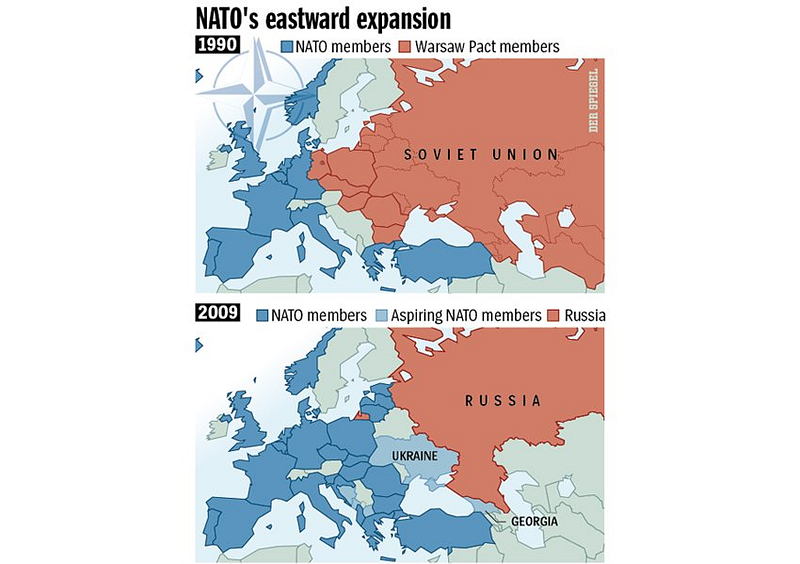
What is important to know is nothing existed in writing between Russia and NATO in regards to the future of NATO operations or new NATO member states after the unification of East and West Germany and the dissolution of the USSR into Russia and its former territories. Russia’s position is that NATO has acted aggressively by expanding NATO influence easterly into former USSR territory along with military forces including nuclear weapons that could attack Russia with no warning. When Russia complains about these actions it falls on deaf ears in the West (like in the video above) both in official and media capacities. However, when Russia pushes back in any way, Russia is presented as a bully or aggressor by western media, all hands on deck, ruthlessly tarred and feathered out of context.
But this is not about right or wrong, ethical concerns will be left to erudite historians and philosophers in smoke-filled rooms. No, this is about perception, expectations, and changes in foreign policy: foreign policy is different between US/NATO and Russia, and trouble is brewing because these perceptions and understandings carry over to not just the Balkins and Poland but also influence actions in Syria, naval operation in the Black Sea and the Mediterranean as well as responses to economic sanctions. Given that Russia has intelligently applied the unassailable wisdom of Game Theory, Russia concluded there are no grounds to trust the West given the history of repeated NATO actions and broken promises. For this reason Russia quietly on a very limited defense budget relative to the US has reacted by developing several different classes of very advanced weapon systems (e.g. air defense systems, electronic warfare, hypersonic missiles, dramatically superior artillery and ordnance, and cyberwarfare) in response to this perceived aggression and, consequently, the threshold of escalation to dangerous military actions is much closer than Americans realize because: (1) the bar is lowered to escalation due to technical advances that accommodate desired foreign policy stances (discussed below); and (2) Americans only see one side (and it is badly distorted at that). There are two sides to deeply consider when it comes to military action and Americans are ignorant of the stakes — what are the risks and benefits of being in Syria? Are they in balance?
Cold War 2.0: The Foreign Policy Differences Between Strategic and Tactical Nuclear Weapon
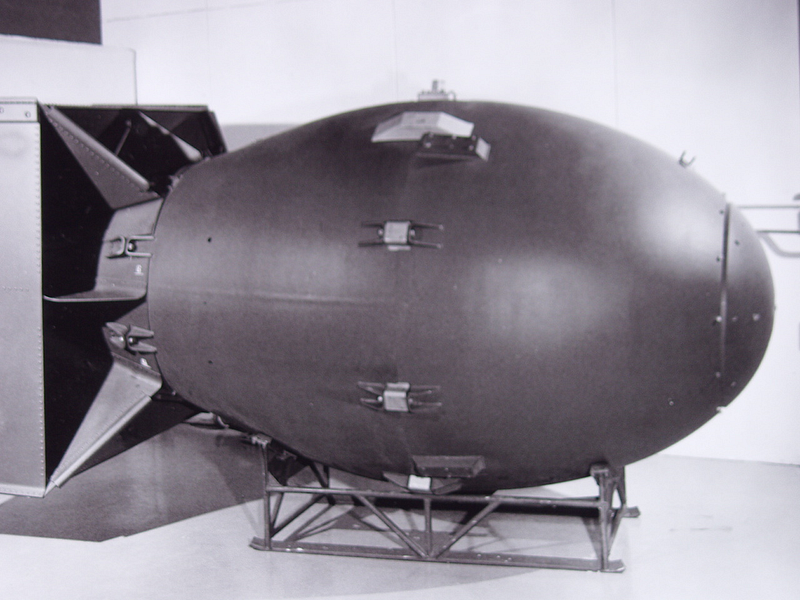

Since the 1950s the world has operated in a world under the “MAD Doctrine” — Mutually Assured Destruction. Sanity has prevailed because the use of strategic nuclear weapons (i.e. hydrogen bombs, manyfold greater in destructive power than the fission nuclear bombs “Little Boy and Fat Man” used in Japan to end WWII) is unthinkable, the end of the world, etc. But the landscape has changed dramatically since the 1950s and the social hive mind is still stuck in MAD. Just like the first computer has miniaturized and proliferated from the room-sized ENIAC down to a trillion Internet of Things, so have nuclear weapons from the original 10,800 pound Fat Man to a panoply of highly-diverse nuclear weapons applications and forms; both of these technological revolutions have dramatically changed the world you live in very different ways except one of them you have never heard of until here and now in terms relative to your well-being. Nuclear weapons have been developed that scale-down to as little as 2% of the destructive power of the Hiroshima bomb and these weapons can be deployed in cruise missiles, laser-guided munitions, bunker busters against hard targets or even as nuclear artillery*. These weapons are qualitatively not just different but are an entirely new genre of weapons that are not only not doomsday weapons but ones that can serve multiple military tasks — they just haven’t been used, yet.
The technological evolution of nuclear weapons through miniaturization, engineering techniques applicable to weapon’s grade nuclear materials and their environmental impact, and extremely precise guidance systems has opened up surprising tactical applications; it is just that both Russia and US/NATO have different visions for their use. The difference between the old Cold War and Cold War 2.0 is that the unthinkable is not only thinkable but has moved into the utilitarian realm and, in a perverse way, according to some — “humane.” Ergo, Cold War 2.0 is no longer cold, it has thawed and the temperature is rising. We live in a different world now and the complacency that has been engendered about the use of nuclear weapons is a misplaced one and dangerously so in Europe and Syria given the technical complexities, policies, assumptions and historical nuances cited above. The new weapons make the old rules of engagement quaint and, resultantly, the new rules — mostly unwritten if assuming unforeseen real combat conditions — presently are an opaque, mercurial gray zone whereas before they were always distinctly black and white. Very quietly, leading-edge militaries have mutated a new species of warfare: where once there was only conventional kinetic or strategic nuclear war, now you have:
- conventional kinetic warfare;
- a network of conventional, electronic (EW), tactical nuclear, space and cyberwarfare in limited but highly-integrated use; and
- strategic nuclear war.
But shouldn’t there be another quasi-step between the second and the third levels where there is a higher bar set for tactical nuclear and society-crippling cyberwarfare use? If so, what, in pragmatic terms, precisely defines that gradation? In reality, three levels is an oversimplification. Actually there is a new warfare continuum that scales up in a foggy blur from a peacetime background of constant cyberterrorism (surveillance, espionage and data theft that is purely informational) to conventional kinetic to elements of the in-between step on its way to full escalation terminating in strategic nuclear war. Once again, all of this has quietly snuck up on us, we are in uncharted territory without public admission or debate — but here we are.

*Note: Nuclear artillery no longer deployed but they did exist in large quantities on both sides.
Russia’s Perspective on the Use of Tactical Nuclear Weapons
Simply: Russia views NATO’s actions post-1990 as very aggressive and underhanded. Russia’s foreign policy has internalized these transgressions and fine-tuned proposed future scenarios and responses — as evidenced by their foreign policy in regards to the use of tactical nuclear weapons — and carries a categorically different footing with tactical as opposed to strategic nuclear weapons:
A second reason that nuclear weapons could be used is that both Russia and the United States are capable of employing these arms in limited and relatively controlled ways. Such more discriminate usage has long been recognized as a potential way to gain value from nuclear weapons beyond threats of general use, the implementation of which would likely be tantamount to suicide. Such limited employment can be contemplated for purely “tactical” or military purposes, for instance in order to redress a deficiency in conventional military capability. Such use can also be contemplated to seek to manipulate risk by communicating in the most credible way — through actual use — that one is prepared to move closer to general war, in the hopes of persuading the other side that further escalation or continuation of its course is too perilous.
(Source: Carnegie Endowment for International Peace, Elbridge Colby, February 26, 2016, “The Role of Nuclear Weapons in the U.S.-Russian Relationship”)
Russia would use tactical nuclear weapons in a defensive posture to hopefully de-escalate a situation to avoid escalation to strategic nuclear weapons use. In other words, let a small genie out of the bottle as a means to keep the big genie in the bottle:
The doctrine introduced the notion of de-escalation — a strategy envisioning the threat of a limited nuclear strike that would force an opponent to accept a return to the status quo ante. Such a threat is envisioned as deterring the United States and its allies from involvement in conflicts in which Russia has an important stake, and in this sense is essentially defensive. Yet, to be effective, such a threat also must be credible. To that end, all large-scale military exercises that Russia conducted beginning in 2000 featured simulations of limited nuclear strikes.
De-escalation rests on a revised notion of the scale of nuclear use. During the Cold War, deterrence involved the threat of inflicting unacceptable damage on an enemy. Russia’s de-escalation strategy provides instead for infliction of “tailored damage,” defined as “damage [that is] subjectively unacceptable to the opponent [and] exceeds the benefits the aggressor expects to gain as a result of the use of military force.” The efficacy of threatening tailored damage assumes an asymmetry in a conflict’s stakes. Moscow reasoned when it adopted the policy that, for the United States, intervening on behalf of Chechen rebels (for example) might seem a desirable course of action for a variety of reasons. But it would not be worth the risk of a nuclear exchange. Russia, however, would perceive the stakes as much higher and would find the risk of a nuclear exchange more acceptable. Indeed, in the early 2000s, Russian military experts wrote that US interference in the war in Chechnya could have resulted in a threat to use nuclear weapons.
(Source: Bulletin of the Atomic Scientists, Nikolai N. Sokov, March 14, 2014,“Why Russia calls a limited nuclear strike ‘de-escalation’” | Background:The Military Doctrine of the Russian Federation (pdf))
Russia has large stockpiles of tactical nuclear weapons:
These standards suggest, that including its operationally assigned stockpile of 860–1,040 [Ed. non-strategic “tactical” nuclear] warheads, Russia currently maintains an overall stockpile of approximately 1,900 non-strategic nuclear warheads not scheduled for dismantlement.
(Source: Royal United Services Institute, November 2012, “VIII. Conclusion”, p. 69, Atomic Accounting: A New Estimate of Russia’s Non-Strategic Nuclear Weapons (pdf))
The US’ Perspective on the Use of Tactical Nuclear Weapons
The US clearly justifies the use of tactical nuclear weapons on technological and biological merits — they are simply better weapons for certain specific tasks, period. Like the present use of laser-guided munitions, tactical nuclear weapons would minimize collateral damage relative to conventional approaches under certain conditions. In other words — theoretically—the concepts of “nuclear weapon” and “surgical strike” perversely became bedfellows:
In an interview, James N. Miller, who helped develop the modernization plan before leaving his post as under secretary of defense for policy in 2014, said the smaller, more precise weapons would maintain the nation’s nuclear deterrent while reducing risks for civilians near foreign military targets.
“Though not everyone agrees, I think it’s the right way to proceed,” Mr. Miller said. “Minimizing civilian casualties if deterrence fails is both a more credible and a more ethical approach.”
General Cartwright summarized the logic of enhanced deterrence with a gun metaphor: “It makes the trigger easier to pull but makes the need to pull the trigger less likely.”
(Source: New York Times, William J. Broad and David E. Sanger, January 11, 2016, “As U.S. Modernizes Nuclear Weapons, ‘Smaller’ Leaves Some Uneasy”)
US wavelengths of thought relative to tactical nuclear weapons venture off the deep end, completely untethered to global circumspection…:
The great thing about nuclear weapons was that their use was supposed to be unthinkable and they were therefore a deterrent to contemplation of a new world war. Once they become ‘thinkable’ we are in a different, and much more dangerous, universe.
It is a universe in which former vice president Dick Cheney has apparently lived for some time. The new biography of George H W Bush has served as a reminder that in the run-up to the first Gulf War, Cheney commissioned a Pentagon study to find out how many tactical nuclear weapons it would take to kill a division of Saddam Hussein’s Republican Guard. The answer was apparently 17.
(Source: The Guardian, Julian Borger, November 10, 2015, “America’s new, more ‘usable’, nuclear bomb in Europe”)
Technically-speaking, small and accurate tactical nuclear weapons improve mission success rate while reducing damage and fallout to “acceptable” levels. Stated differently, given the inventory of conventional weapons available today, for specific mission classes a tactical nuclear is (theoretically, sans sociological and political impacts) a more efficient, humane, less collateral damage-producing weapon:
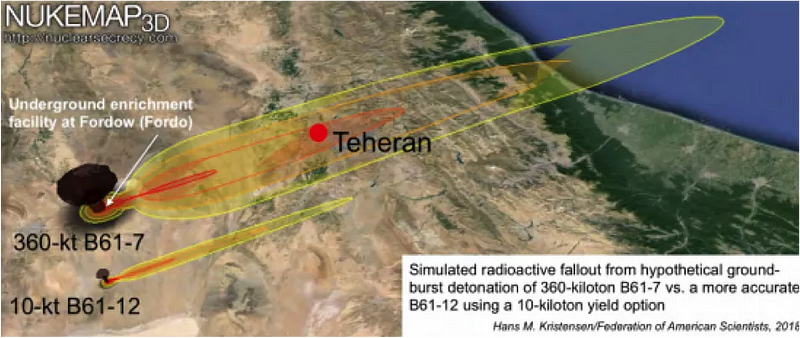

The US is currently modernizing the old B61 weapons family and completed testing of the B61–12 in 2015 but are not yet deployed. Until then, the B61–4 and B61–7 are the most advanced in the arsenal. There are many places in Europe where they are stockpiled included around 50 in Turkey.
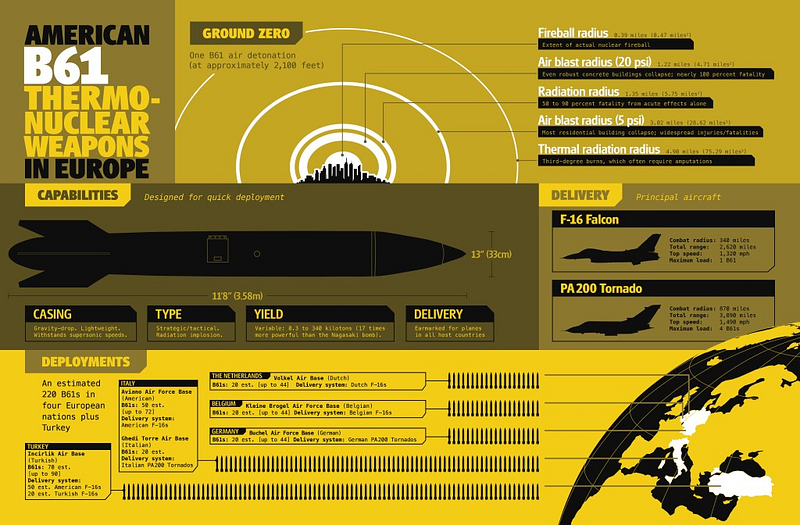
Yet, in contradictory fashion, the same unique technical qualities that make the B61–12 a more accurate, secure, and effective U.S. nuclear deterrent also conjure implied risks with the potential to negate any positive impacts.
By significantly increasing accuracy and eroding the barriers to use previously presented by unintended casualties, the B61–12 does indeed increase the deterrent capability of the United States — but it also poses the contrary reality of an increased probability that nuclear weapons will actually be launched.
This concept of greater usability entirely forgoes the core assumption ofdeterrence theory, which asserts that credible nuclear deterrents are always present but never utilized. In short, B61–12s will broaden the range of circumstances that U.S. military strategists might reasonably consider employing nuclear weapons, a move which in turn would naturally create an immediate possibility of escalation towards full-fledged nuclear war.
In addition, the sheer expense and symbolism of creating a highly modernized, highly precise nuclear weapon like the B61–12 challenges the notions of nonproliferation and disarmament.
(Source: Global Risk Insights, Ian Armstrong, January 8, 2016, “The Pentagon’s New Nuclear Gravity Bomb”)
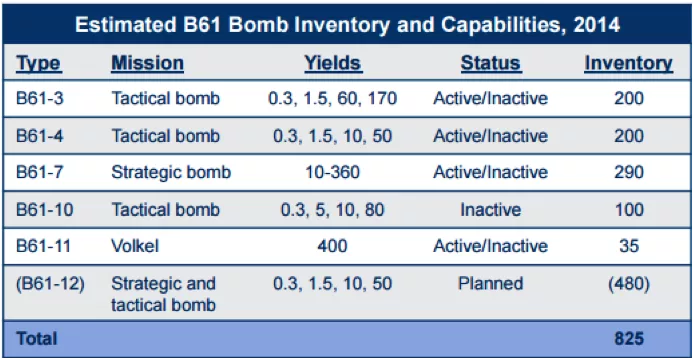
Russia Is Transforming Syria from a Temporary Base of Operation into a Geopolitical Region of Strategic Importance
Part of Russia’s foreign policy in regards to appropriate use of tactical nuclear weapons is in defense of strategic assets that threaten Russian interests:
[Russian] possible criteria for a nuclear response to conventional attack, namely if that attack involves:
• attacks on Russian political-administrative and economic centers, such as Moscow, St. Petersburg, Novosibirsk, Ekaterinburg, Vladivostok, and others
• attacks on military space systems or early warning system
•attacks on general staff command points
• attacks on the Strategic Rocket Forces (SRF)
•attacks on air bases hosting strategic aviation
• attacks on naval bases that host submarine-launched ballistic missiles (SLBMs)
•attacks on Russian SLBMs carrying out patrols
• attacks by enemy ground forces on Russian territory if Russian conventional forces cannot halt their progress.
(Source: “Rossiiskoe Iadernoe Oruzhie: Kriterii Primeneniia,” 2010, within: Rand Corporation, 2011, Nuclear Deterrence in Europe: Russian Approaches to a New Environment and Implications for the United States, “Chapter Three: Russia’s Claimed Interests and Military Planning in Europe”, p. 32 (pdf))
Now we are ready to revisit Syria:
Russia plans to build a full-scale military airbase and to deploy a permanent contingent of aircrafts in Syria. The paper’s source at the Russian Ministry of Defense confirmed the existing infrastructure of Khmeimim — Russia’s current air base in Syria — will be expanded substantially, enabling the deployment of heavy aircrafts [include a loading dock for Antonov An-124 Ruslan heavy military transport aircrafts] from Khmeimim in the near future.
Khmeimim will be surrounded by ramparts to protect against enemy fire and bombing. The base will be outfitted with new radio-technical equipment — including an air traffic control system — and a full-fledged military town for the Russian troops stationed there.
The Russian Defense Ministry source told Izvestia that, although Khmeimim’s expansion has been planned since the end of 2015, the deal wasn’t official until two days ago. Last Tuesday, Moscow and Damascus signed an agreement giving Khmeimim to Russia in perpetuity, free of charge and out of the jurisdiction of the Syrian government.
(Source: Observer, Mikhail Klikushin, August 12, 2016, “Russia Hints It Might Hide Nukes in Syria”)

http://twitter.com/SyriaInstitute/status/763818801146191872?ref_src=twsrc%5Etfw

What’s happening in Syria is that Russia, with full legal authority granted by the Syrian government, is pivoting from a temporary military base of tactical operational status to a permanent and fully-operational base and will now view operations on the coast of Syria at the naval base in Tartus and the Khmeimim Air Force Base around 50 miles away near Latakia as constituents of their strategic assets and will protect them under their foreign policy doctrine relative to tactical nuclear weapons use. In other words, extending the chess metaphor, Russia first brought a rook to the center squares with the S-400 and now the queen follows suit. Once again, a murky gray zone: How do you interpret Russian foreign policy? Do you think that they think they are Russian strategic assets? There is only one way to find out*. And making assumptions steeped in egregious miscalculation is what births escalation right up the ladder to strategic nuclear weapon use and a perilous game of atomic chicken like the Cuban Missile Crisis. We could get to the edge easily with just a few seemingly innocuous “shows of force” early in a “there’s a new sheriff in town” White House administration and then something eerie happens.
*Note: Raytheon, A US defense contractor, claims to have developed weapon systems capable of defeating Russian air defense capabilities [video |website]. Unfortunately, whether this is true or not has the same far-reaching implications given the volatile geopolitical context in Syria: such action can escalate and terminally yield the lose-lose proposition of MAD.Stated differently, there is an extreme danger in this turbid context of making the grave error of believing you are playing a zero-sum game when in fact you are playing a non-zero-sum game — either side in the game can change the name of the game from zero-sum to non-zero-sum with the flip of a switch in the blink of an eye and it could paint scenarios simultaneously hair-trigger while seat-of-the-pants.
Ramifications
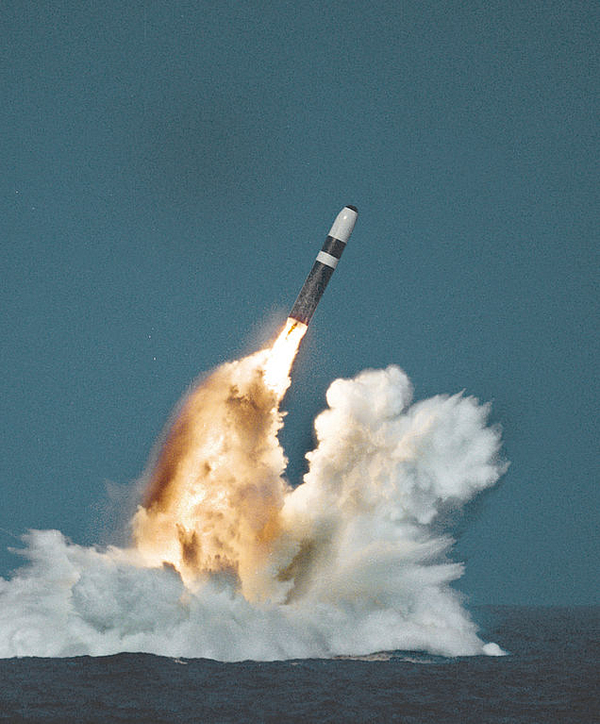
I worked at Lockheed Missiles and Space Company right out of college in the 1980s as an electrical engineer performing quality assurance testing of electronic components for the submarine-launched Trident strategic nuclear missile. Where the missile bodies were manufactured in Sunnyvale, California, in a building longer than a football field, I can still smell the pungent odor of curing epoxy on kevlar blended with the odor of lathes machining parts out of blocks of aluminum and titanium. The missile — 44 1/2 feet long — is not all fancy tech, there is no automation to speak of; instead, there is real craftsmanship, each almost has its own personalty as it comes to rest, dormant, in a submarine missile tube beneath the sea patiently awaiting its first and final mission. It is a strange feeling making something that will destroy all life on earth save bacteria but you get over it. We were told by the President of the company in our indoctrination to the strategic nuclear missile building business: “You want to do the best job you can so that your work-product will be considered so damn good that it will never be used. Otherwise, we failed.” That is not the attitude today in the manufacture and deployment of tactical nuclear weapons: tactical nuclear weapons are not doomsday weapons that are, hopefully, expensive dust collectors and rust buckets; they will be used sooner or later because you don’t really know how far you can push Russia before She pushes back — Russia already feels betrayed because of the turn of events in the aftermath of the USSR’s collapse and poking a cornered bear, that has warned repeatedly while baring fangs with serious recent demonstrations of singular prowess of new genre of weapons systems, is a most dangerous game with no payoff.
There have been discussions on how the US could suppress Russian S-400 air defense networks in Syria if warranted. Technically, it would be difficult to achieve but eventually that could be done at great cost. But that is not the point — this would not be a tactical course of action, it is a strategic one: Russia would interpret it as an act of war and may retaliate according to their foreign policy doctrine on the use of tactical nuclear weapons. Also, for the same reason, retaliation could take the form of full-scale cyberwarfare on US infrastructure and its allies. From there, who fancies a guess?
Fact: the next US president is going to inherit the Syrian Conflict. President Obama in October 2015 said he did not want Syria to turn into a proxy war between the US and Russia; the present administration has chosen to work around Russia, avoiding provocation. Under a Hillary Clinton administration, however, it is very likely that a significantly more aggressive strategy in Syria that would violate the UN resolution (i.e. directly attack the Assad government which is not authorized) will be implemented that could easily have far-reaching, unintended consequences (more…). Donald Trump emphasized 20,000 to 30,000 US ground troops to target the IS in Iraq and Syria.
Given the unprecedented conditions as presented here, being a Commander-in-Chief in today’s world, unlike days of old, requires, at minimum, a working knowledge of the potential continuum of contingencies of complex weapon systems under combat conditions — military decisions that are assumed tactical and limited may not be assumed as such by the other side. Failing this understanding, a Commander-in-Chief is rendered helpless, totally dependent upon professional military advice, and, consequently, given his or her ignorance of such depths as clear matter-of-fact, the de facto Commander-in-Chief is not the President — and not someone in which the electorate willingly chose or even heard of, let alone trust with their family’s future hanging in the balance. Since even the most astute and seasoned military general does not know the consequences of military actions beyond an educated guess given the plethora of known and unknown unknowns, the world’s fate is truly out of control when those ephemeral lines in the sand are crossed in the nuclear matrix:
- Where do you draw the line between not using and using tactical nuclear or cyberweapons?
- Where do they draw the line between not using and using tactical nuclear or cyberweapons?
- Where do you draw the line between tactical and strategic nuclear weapons use?
- Where do they draw the line between tactical and strategic nuclear weapons use?
- What does “proportional response” mean today?
- What is the calculus for assessing the value of “collateral damage” in the context of tactical nuclear weapons? How would the other side interpret it? What about fallout that crosses borders, isn’t that a dirty bomb?
There has never been a public debate about this, why is that?
Is it just too complex to coherently discuss? Or too unpleasant? Could it be plain ignorance? Or is it simply easier to keep the public in the dark even though their lives are unknowingly used as collateral in a high-stakes game of atomic poker?
After all, if the discussion has mutated from unthinkable to thinkable, then why aren’t we thinking about it or at least thinking about who we would feel comfortable thinking about it?
One should proceed with this discussion with an overwhelming acknowledgement of blindsides due to missing large chunks of what you must know but don’t know that you don’t know, where you should expect hubris and naïve judgement to be closer than your shadow, that everyone is out of their depth here. The risk of substituting theory, seat-of-the-pants hunches, and limited test data for actual — but heretofore nonexistent — experience and acumen of robust, real-world, complex military conditions in-theater is a foregone conclusion and this deficiency can quickly snowball into treacherous and unexpected chains of events that cannot be undone. The number, function and interaction of moving parts is multi-dimensional, fluid and unknown from weapons function to communication networks to foreign policy to psychology to assumptions — this cannot be overstated.Nothing has precedent and the consequences of poor judgement are dire.
What stands between US wishes of regime change in Syria are vast technical and Russian foreign policy challenges: if the US destroys the air defense system in Latakia, how do you think Russia will respond given their level of distrust since 1990? Russia already believes they have been pushed to the brink and now you destroy strategic assets without legal authority granted by the UN Resolutions. Once again, repeating, ad nauseam, what is clear and present: how would Russia interpret such action? Do you know? Do you really want to find out given the stakes? Have Putin’s numerous warnings truly fallen on deaf ears? What’s in it for the US? The risk of things getting out of hand should not be classified as a “tail risk,” the risk is much closer to the belly of the curve than you realize.
Will there ever be a natural gas pipeline built in Syria? Most likely not because even if a diplomatic decision were reached it would be next to impossible to stop sabotage due to the fact that Syria will be a hornet’s nest insurgency forever. China and Iran are in discussions for China to invest in liquified natural gas plants and execute natural gas commerce like Qatar has been doing for years which does not require pipelines but does reduce profit margins.
Prudent Actions to Strongly Consider
The Syrian Conflict and ongoing saber-rattling with NATO military exercises in close proximity to Russia’s western borders and Russia responding in kind is a Prevailing Gray Swan with two-heads. The first head is the refugee crisis which will at some point break the back of the EU via a successful Brexit-like referendum in France or elsewhere and the second head is the looming escalation of the use of tactical nuclear weapons and/or unlimited cyberwarfare due to miscalculation of Russian and Iranian response in an attempt to unseat Assad or destroy air defense networks. The cyberwarfare capabilities of Iran + Russia + China could bring any country to its knees indefinitely (see the separate Prevailing Gray Swan on cyberterrorism).
The US needs to tread carefully in Syria given no reasonable upside; Russia is in the catbird seat legally and militarily, not the US and NATO. Iran, Syria, Russia and China are allies and everyone who understands the Syrian Conflict knows that neutralizing the IS is only part of the equation. The rest of the equation is kept out of the public eye in main street media but it’s time for people to wake-up for both a gut and reality check.
There is no specific action you can take relative to military escalation other than general preparation but the risk of the collapse of the EU mandates the same prudent measures as a successful French or Italian referendum like Brexit: the eurozone is deceptively fragile and is one accident away from unraveling; it is not a safe place for bank deposits subject to recent eurozone bail-in laws. This is explored in-depth in the European Union Prevailing Gray Swan.

Prepared by: James Autio
Conflict of interest: none
doctorgo@gmail.com

___
http://medium.com/deepconnections/prevailing-gray-swans-6-august-12-2016-329f8118a4b6#.r5xa3yroz
